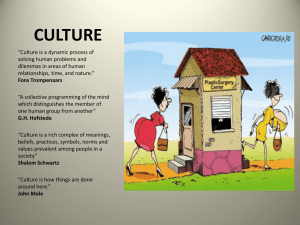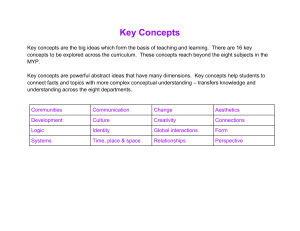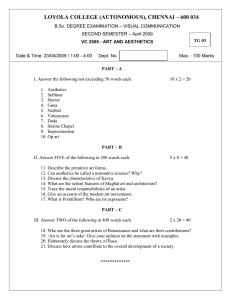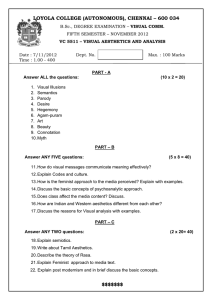Social and Cultural Environments Global Marketing
advertisement
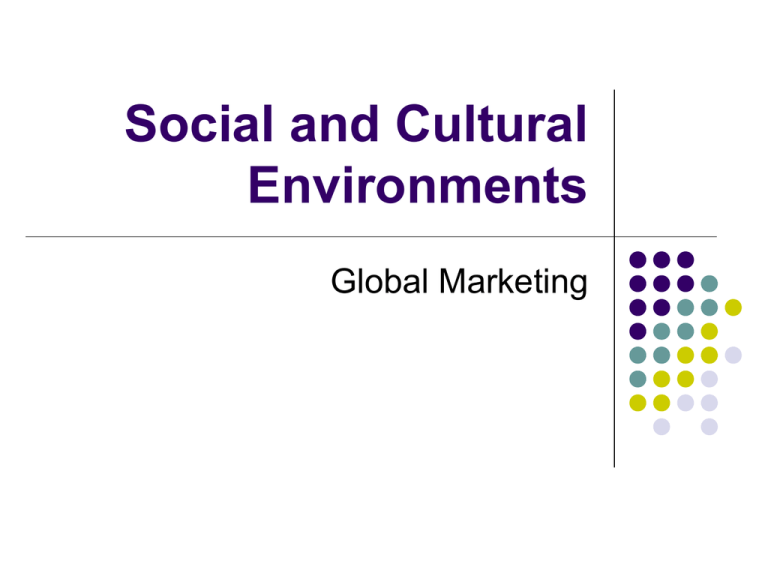
Social and Cultural Environments Global Marketing Culture is… …a system of values and norms that are shared among a group of people and constitute a design for living by Hofstede Acculturation Adjusting or adapting to a specific culture other than one’s own. It is a key managerial factor of success in international operations Culture #2: Ways of living, built up by a group of human beings, transmitted from one generation to another Social institutions Family; Education; Religion; Government; Business – all included in the term of culture Material vs. Non-material Culture Physical components of culture Objects Artifacts Clothing; Tools; Pictures; Homes Subjective or abstract culture Religion Perceptions; Attitudes Beliefs; Values Marketing: is able to influence and often to change both physical and abstract cultures (Global Teens, Yuppies) Cultural Universals: interacting dimensions of a culture (Murdock) Athletics - Body adornment Cooking Courtship Decorative arts Education Ethics Property rights Religious rituals Etiquette Family feasting - Food taboos Language Marriage Mealtime Mourning Music Status differentiation Beliefs and Attitudes Values and Norms Values: shared beliefs about what is right and wrong. How things ought to be? Ex: Is “being selfish” appropriate or not? Aesthetics Aesthetics: Values and norms about beauty and taste Marketing and aesthetics: local and regional tastes require modifications in the 4Ps Aesthetics and Color What do you associate with Red? With White? Dietary Preferences What would you eat? Reindeer (Finland) Rabbit or frogs (France) Rice, soup, and grilled fish for breakfast (Japan) Raw Fish (Japan) Kimchi (fermented veggies, Korea) Blood / Black sausage (Germany, Scotland, Hungary) Language and Communication Verbal Language: spoken language, including Morphology: how words are formed, are they similar to other languages Syntax: rules of grammar, sentence formation Phonology: how they pronounce the words Semantics: the meaning of the words Nonverbal Language Measuring Cultural Differences: High Context Cultures (Hall) Information resides in context It’s very important where, how, with whom, and at what time we conduct business Measuring Cultural Differences: Low Context Cultures Messages are explicit and specific Words carry all information High vs. Low Context Factors High Context Low Context Lawyers Less important Very important A person’s word His or her bond Must “get it in writing” Responsibility Accepted at highest level Pushed to lowest level Personal Space Close Private space needed Time Polychronic Monochronic Negotiations Lengthy Proceed quickly Competitive bidding Infrequent Common Measuring Cultural Differences: Hofstede’s Cultural Dimensions (Geert Hofstede, Dutch social-psychologist) Ethnocentrism and the Self-Reference Criterion Potential Problems in Management The International Product Life Cycle: There is no uniform diffusion process Environmental Sensitivity: greatly influences the degree of product adoption in a country NESTLE COMPAQ INTEL


